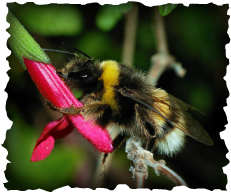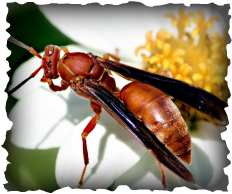|
|
Africanized honey bees, known colloquially as "killer bees", are some hybrid varieties of the Western honey bee species, produced originally by cross-breeding of the African honey bee with various European honey bees such as the Italian bee and the Iberian bee. The hybrid bees are far more defensive than any of the various European subspecies. Small swarms of Africanized bees are capable of taking over European honey bee hives by invading the hive and establishing their own queen after killing the European queen. They tend to swarm more frequently and go farther than other types of honey bees, guard the hive aggressively with a larger alarm zone around the hive and lives more often in ground cavities than the European types.
|
Differences Between Africanized Honey Bees and European Honey BeesBoth bees look the same, sting in defense of themselves or their nest, can only sting once, and have the same venom.
Africanized honey bees are slightly smaller. Africanized bees can sense a threat from people or animals 50 feet or more from their nest and sense vibrations from power equipment 100 feet or more from their nest. |
|
Bumblebees are social insects that are characterised by black and yellow body hairs, often in bands. However, some species have orange or red on their bodies, or may be entirely black. Another obvious characteristic is the soft nature of the hair, called pile, that covers their entire body, making them appear and feel fuzzy. Bumble bees are similar to their close relatives, the honey bees, in that their colonies are headed by a queen & they have many workers and drones. However, the colonies of bumble bees, unlike those of honey bees, only survive during the warm season.
|
|
Wasps make up an enormously diverse array of insects, with some 30,000 identified species. Wasps are distinguishable from bees by their pointed lower abdomens and the narrow "waist," called a petiole, that separates the abdomen from the thorax. They come in every color imaginable, from the familiar yellow to brown, metallic blue, and bright red. Generally, the brighter colored species are in the Vespidae, or stinging wasp, family. All wasps build nests. Whereas bees secrete a waxy substance to construct their nests, wasps create their familiar papery abodes from wood fibers scraped with their hard mandibles and chewed into a pulp. A social wasp in distress emits a pheromone that sends nearby colony members into a defensive, stinging frenzy. Unlike bees, wasps can sting repeatedly.
|
|
Hornets are wasps of the genus Vespa, closely related to (and resembling) yellowjackets. There are about 20 hornet species. These social insects construct hives by chewing wood into a papery construction pulp. These insects eat some tree sap but they are also accomplished predators. A hornet hive will eliminate many flies, bees, and other insects. Workers defend their hive with potent stingers. Though these insects do not sting humans unless provoked, some people are allergic to their venom and can have very dangerous reactions to a sting. Hornets are often considered pests, particularly when they nest near humans, because they will defend a nest aggressively if they feel it is threatened. Though many people fear their sting, hornets usually get the worst of such encounters when their nests are poisoned or destroyed.
|






